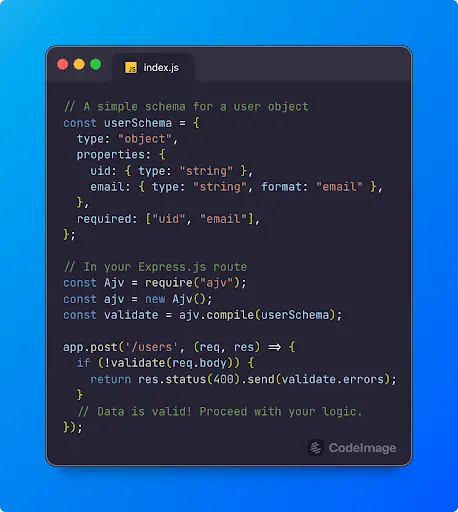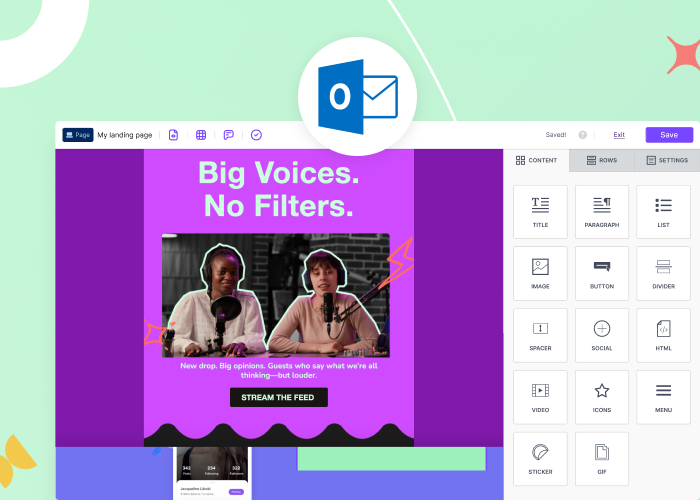If I asked you if you know JSON, you’d probably say yes. Of course you do. We see it every day in API responses, in our package.json files, and in configs everywhere. We treat it as a simple format for transferring data but what if that's like using a jet-fueled supercar just to drive to the grocery store?
The truth is, many of us are only scratching the surface of what JSON is truly capable of. When we see JSON as just a data format, we miss its real potential. Viewing it as more of an architectural tool unlocks its superpowers. Let's explore a couple of these lesser-known patterns and then look at a real-world system built on this philosophy.
Superpower #1: JSON as a contract with JSON schema
Imagine your Node.js API gets a POST request. How do you know the data is valid? You could write a ton of if statements, or you could use a contract. A contract in this case is a blueprint for both the API provider and consumer, ensuring a mutual understanding of the API's functionality and behavior. JSON Schema is a specification that lets you define these "rules" for your JSON data. You can enforce data types, required fields, string patterns, and more.
By using a validator library like Ajv in your application, you can check incoming data against this contract in just a few lines.

This pattern turns your API from a passive receiver of data into more of a gatekeeper, ensuring data integrity before it ever touches your business logic or database. Where the old adage is “garbage in, garbage out”, this is a straightforward means of keeping the garbage from ever entering the equation.
Superpower #2: JSON as a blueprint for UI
This is a non-traditional use case with tons of potential. What if your UI wasn't hardcoded in React or Vue components, but was defined by a JSON document that your components simply knew how to render? This pattern is referred to as using JSON as a Domain-Specific Language (DSL) for UI.
By defining the UI structure, layout, and content in a JSON object, you decouple your presentation from your application logic. Your UI becomes dynamic, configurable, and portable. You can store it in a database, send it over an API, and render it consistently across different platforms, all from a single, predictable "blueprint." Similar to the validation example, there is a “contractual understanding” of how the UI will be displayed.
These days, content creators who are building in the dynamic UI space of online video are testing, creating and defining entire video scenes in JSON then feeding that file to an appropriate AI-powered video generation tool such as Imagen or Veo3. In addition to improvements in quality, scene-to-scene consistency gets a boost from the control offered in key-value pairs.
To take things a step further, Google's Vertex AI for Vision uses JSON to define and manage video datasets and annotations, one key step in training AI models for video-related tasks.
Putting your JSON to work: Two common plays
Thinking about it, a Beefree design is more than a pretty email. What you have is a predictable JSON object. Here are two common plays we see developers use to get the most value out of that fact.
Play 1: Modernize old templates
- The problem: You're handed a folder full of old, static HTML email files. Your marketing team needs to update them, but for all practical purposes, the content is locked down and impossible to manage.
- The play: Build a transformation workflow to solve this. Using the HTML Importer API, you feed in the old files, and it returns the predictable JSON blueprint the editor needs. This play allows you to take an entire library of outdated templates and make them fully editable for your team, saving them from countless hours of manual work.
Play 2: Build a content factory
- The problem: Your application needs to generate thousands of personalized emails on the fly. Think of injecting a customer's name or specific order details into a standard template, all done automatically.
- The play: Because the "source of truth" for a design is structured JSON, you can manipulate it directly from your backend code. You don't even need to open the visual editor. Using the Content Services API, a script in your backend can fetch a template's JSON, programmatically add the user-specific data directly into the object, and then render the final personalized HTML. It effectively turns your templates into a content factory, allowing you to treat email designs just like any other data in your application.
Conclusion
My challenge to you is this: the next time you start a project, instead of thinking of JSON as a way to send data back and forth, think bigger. Ask yourself, "Can I use JSON to define the core blueprint of this feature?" “Do I have future maintainability or extensibility concerns that JSON could serve better than my existing model?” The answer to those questions just may lead you to superpowers you didn't know you needed, leading to more resilient, scalable, and flexible applications.
If this idea sparks your interest and you want to see these patterns in the real world, a great place to begin is our Quickstart Guide on Github. You can explore real code that puts these plays into practice. For an even deeper dive into all the tools available, head over to the Beefree SDK documentation.
Now, go build something great.

.webp)



.webp)